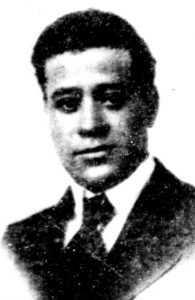 Horace Sudduth (1888-1957) was the wealthiest African American of his generation in Cincinnati, and its most influential Black businessperson. Like the nineteenth century Black coal merchant Robert Gordon, Sudduth moved from the city basin to Walnut Hills, and did much of his business in our neighborhood. His core work was real estate, and he made most of his fortune brokering, buying, selling, and managing housing properties. He founded and served as the president of the Industrial Building and Loan, a bank that provided savings accounts and mortgages to African Americans in the old West End and in Walnut Hills; for his efforts he took only a token single dollar as annual compensation. He owned and developed the Manse Hotel, one of our neighborhood’s cultural centers.
Horace Sudduth (1888-1957) was the wealthiest African American of his generation in Cincinnati, and its most influential Black businessperson. Like the nineteenth century Black coal merchant Robert Gordon, Sudduth moved from the city basin to Walnut Hills, and did much of his business in our neighborhood. His core work was real estate, and he made most of his fortune brokering, buying, selling, and managing housing properties. He founded and served as the president of the Industrial Building and Loan, a bank that provided savings accounts and mortgages to African Americans in the old West End and in Walnut Hills; for his efforts he took only a token single dollar as annual compensation. He owned and developed the Manse Hotel, one of our neighborhood’s cultural centers.
Sudduth opened his real estate business in the old West End. A natural, he quickly found his way into the small circle of successful African American businessmen. He grew especially close to Wendel P. Dabney, the editor of the Black newspaper in town called The Union. He also, through both business and philanthropic connections, knew and cultivated many wealthy, progressive whites. This is the first in a series of posts that will follow Sudduth’s career in real estate, banking, entertainment, politics, hotel and restaurant management – but also his role as a philanthropist, a community leader and a cultivator of business talent in the African American community in Cincinnati and especially Walnut Hills.
Horace Sudduth was born in Covington Kentucky, just across the river from Cincinnati. Kentucky’s schools remained segregated by law until a decade after Brown vs Board of Education in 1954. It is ironic to note that legal integration in Cincinnati led to the closure of the Black Gaines High School in our city about the time Sudduth was born – also about the same time that Covington established its Seventh Street Colored School including the William Grant High School. Horace Sudduth, the child of poor working African American parents, graduated from the school in 1906.
The accidental superiority of a supportive high school education for Blacks in Covington over those in Cincinnati did not result in local employment opportunities. Sudduth, an eighteen-year-old high school graduate, looked to the national labor market. He went to work for the Pullman company, the country’s largest employer of African American men. The all-Black workforce, in railroad terms poorly paid and overworked, nonetheless constituted a well-educated elite. While many of the porters made a full career of the grueling life on the rails, the job also served as a steppingstone for young, articulate men to gain some experience in the world, make some money, and launch careers in the segregated Black economies of American cities.
Sudduth tried his luck at real estate in Oklahoma, just as it became a state in 1907. It seems he made some money and launched a promising career. He was able to give up his job as a porter. Economically settled, he returned to Covington to woo his high school sweetheart Melvina Jones. She accepted his proposal but refused to move to Oklahoma. The Sudduths settled in Cincinnati in 1910.
Geoff Sutton
For more, see Horace Sudduth: Businessman, Philanthropist, WH Resident
References:
Middleton, Stephen. “‘We Must Not Fail!!!’: Horace Sudduth, Queen City Entrepreneur.” Queen City Heritage 49 (Summer 1991): 2-20. Online at http://library.cincymuseum.org/journals/files/qch/v49/n2/qch-v49-n2-wem-003.pdf
Middleton’s is the definitive biographical sketch of Sudduth. On the whole he covers Sudduth’s business, philanthropic and social networks quite thoroughly. He includes a wonderful array of images. There are a few minor quibbles – he conflates Sudduth’s own eponymous real estate office from about 1910 with the publicly available Creative Realty investment vehicle he founded a decade later, and he does not touch on Sudduth’s relations with Donald Spencer. But Middleton is by far the best source, and all the more remarkable for his thoroughness in the days before the internet.
Sudduth was also profiled as one of “Three Cincinnatians of Worth” by Will Smallwood in Opportunity, 1947, pp 85-86 published by the National Urban League. It is a more intimate sketch, probably owing primarily to an interview, with little no documentation.